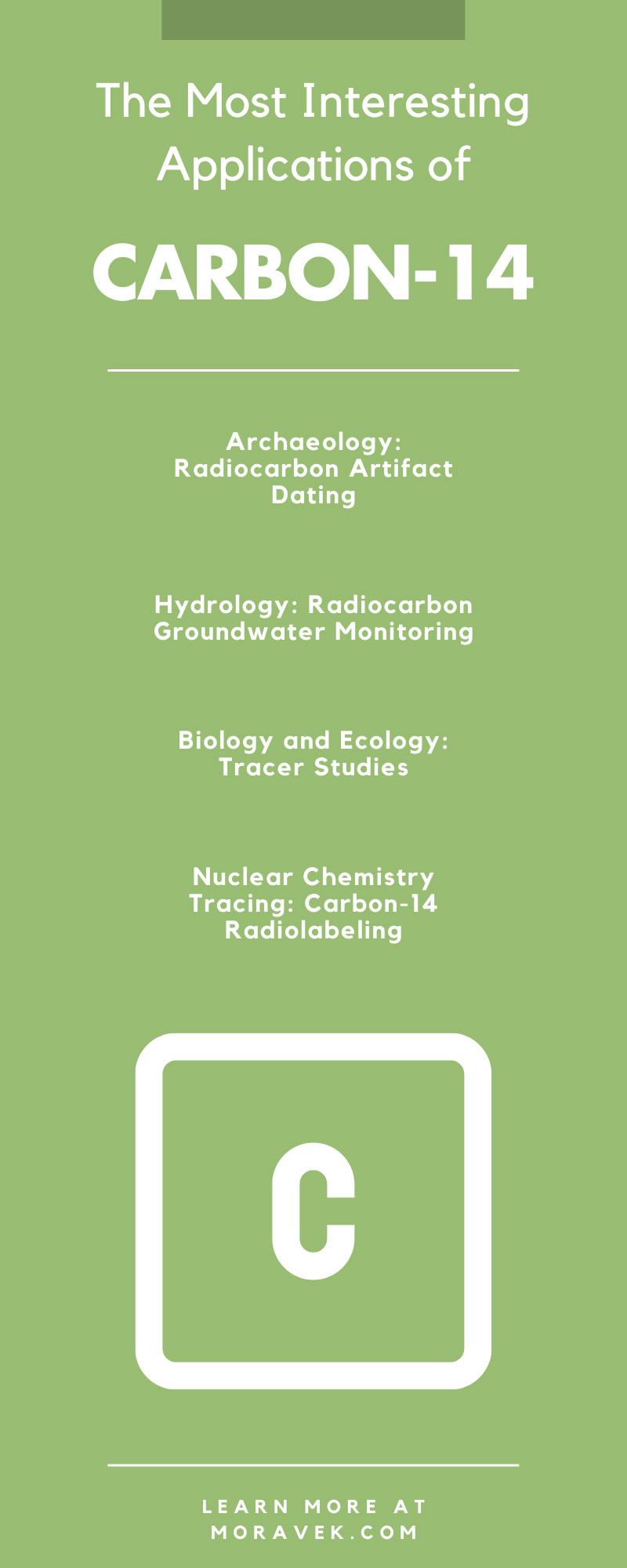Carbon-14 is an isotope with six protons and eight neutrons within its nucleus—two additional neutrons in contrast to carbon-12. Carbon-12 is the isotope traditionally found within the atmosphere and the human body. Those two extra neutrons make all the difference, creating an unstable atom that decays radioactively. Due to its unique radioactive properties, we can trace and follow carbon-14’s revolutionizing trail through numerous scientific disciplines. Matter-of-fact, this radioisotope of cosmic origin can solve some of the world’s greatest mysteries and answer some of its unresolved questions.
We’ve compiled a list of the most prominent and interesting applications of carbon-14 in our modern world. Let’s examine closer the exceptional applications found within the following fields of study:
- Archaeology
- Hydrology
- Biology
- Nuclear chemistry
Archaeology: Radiocarbon Artifact Dating
Archaeology is the study of human culture, cultivated throughout the analysis of recovered materials from past human life and activity. How do archeologists determine the relative age of prehistoric samples, sites, and artifacts? With its key tool: radiocarbon dating, the main workhorse of carbon-14.
This cosmogenic technique may be a prominent and well-known application, but denying that carbon dating isn't one of the most interesting applications of carbon-14 would disregard its ultimate value. Carbon-14’s decay is a fascinating clock that lets humanity peer into the windows of the past in the twenty-first century.
How Radiocarbon Dating Works
Every living thing contains a trace quantity of radioactivity, with a set amount of radiocarbon within them. Carbon-14 causes no detrimental effects to a living organism, making the isotope a natural and functional timekeeper for organic materials. When a living being passes away, carbon-12 remains in the body while carbon-14 decays at its predictable rate. Scientists can then determine the time of atmospheric absorption by comparing this ratio within an organic sample.
Radiocarbon dating is suitable for organic materials of 50,000 years old or younger. Archeologists can carbon-date samples of once-living artifacts within this given timeline. These samples include human remains, clothing, books, food, etc. Essentially, carbon dating humanmade or material possessions can shed greater light on human evolution.
Think carefully in order to not confuse the footing of archeology and paleontology. Reconstructing the ancient timeline of once-living things isn’t a resolute possibility with radiocarbon dating. Paleontologists often cannot directly date fossils themselves and instead must use isotopes with a longer half-life, such as uranium, to approximate age.
Hydrology: Radiocarbon Groundwater Monitoring
Hydrology is the study of water—water that's either on or beneath the Earth’s surface. This science focuses on the movement, distribution, and occurrence of terrestrial water. Hydrology also concerns itself with the direct influence of human activities upon its prevalent availability and current conditions.
Carbon-14 has several hydrological applications, including the radiocarbon dating of groundwater. This process provides hydrologists with a tool to better monitor, understand, and control the mistreatment of aquifer environments. Carbon-14 field measurements grant valuable insight into the pathways of flowing groundwater and any sources or areas of recharge. For example, research studies using isotopic methods and approaches help determine 1) the age and 2) the location origin of water within a basin.
Another interesting application of radiocarbon with this field of study is the prediction of possible water contamination. Time-based monitoring correctly dates incoming water sources and reveals vital information about their contents. For example, measurement of the radiocarbon content within a ground well provides details about the stability of the water source around the head of the well's pump. Using this surveying technique, scientists identify potentially contaminated water sources that could reach valuable water supplies. The early-on discovery and cataloging of at-risk surface waters are key for human safety.
Biology and Ecology: Tracer Studies
Applications of carbon-14 in our world tie heavily to our natural living environment. Biology is the study of living organisms—of function, growth, evolution, and origin. Out of all life on Earth, plants are the most prevalent organisms. Vegetation plays a crucial role in our environment and our modern society. As primary food producers for above-ground creatures and below-ground microorganisms, plant systems are the essence of our ecosystem. How can we learn more about their processes?
Carbon-14 tracer studies in biology commonly follow the steps found in biological processes and chemical reactions. Radiocarbon makes an effective tracer to follow these pathways. Radioactive tracers are particularly useful in examining the dynamics of nutrients within the soil, plant, and atmosphere cycle.
Additional applications are available in the sub-sector of ecology and the study of relationships between living organisms. A prime example is the employment of carbon-14 to understand the blueprint of photosynthesis pathways. Biologists use mass spectrometry to uncover the foundational instruments of the photosynthesis process. Further radioisotopic methods beyond carbon-14 have relevance in present-day agriculture and ongoing crop production.
Nuclear Chemistry Tracing: Carbon-14 Radiolabeling
Nuclear chemistry—also known as radiochemistry—studies radiation from a molecular frame of mind. Radiochemistry is a pivotal science for the modern-day medical, industrial, and research industries, especially pharmaceuticals. Radioactive isotopes carry a wide array of applications within medical diagnostics, care, treatments, and research.
Carbon-14 is the regulatory isotope of choice due to its long half-life, defined label position, and sensitivity for qualitative detection. Researchers widely use carbon-14 for the isotopic labeling of molecules to test for the safety and efficiency of drug products within the human body. Radiolabeling can either uncover newer metabolic pathways or track the metabolism route of newly-created pharmaceutical molecules in vivo.
Moravek is a contract manufacturer of radiolabeled compounds and active pharmaceutical ingredients. Our company is fully licensed to prepare hydrogen-3, sulfur-25, and carbon-14 labeled APIs for research groundwork in clinical trials. We provide custom radiolabeled synthesis services to meet the specifications of challenging projects. Moravek strives to provide high-quality service with flexibility to meet the requirements of any specific study. Contact us with any questions about our radiolabeled compound synthesis, purification, or testing methods today.

